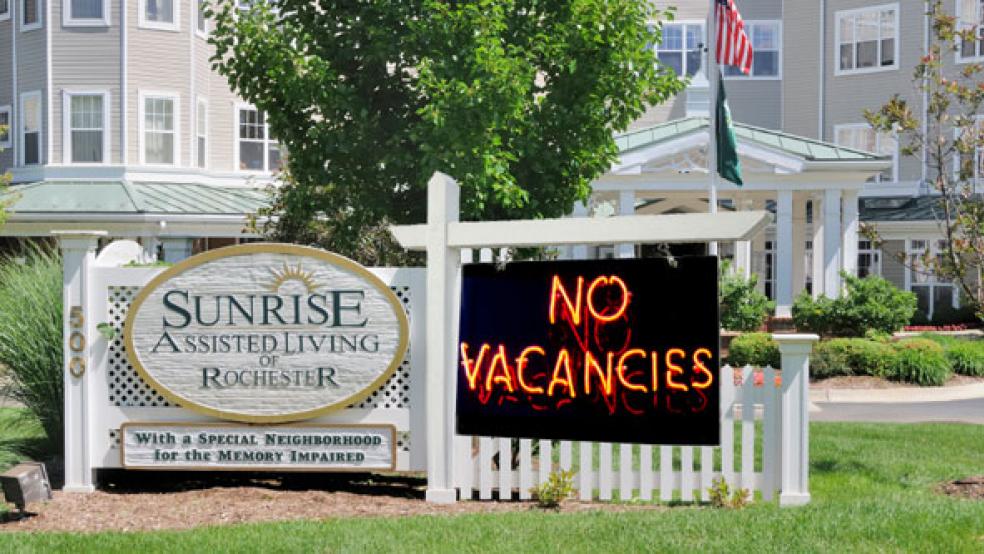The latest casualty of the Great Recession may soon be the nation's elderly. Cuts in government payments for patient care and less construction of new nursing homes are already taking a toll. Add to this the aging baby boom generation and you have a worst-case scenario in which older people who need full-time care won't be able to get it. “We believe we’re at a tipping point,” says Mark Parkinson, head of the American Health Care Association (AHCA), which represents nursing homes.
Related: New Cancer Drugs: Affordable by the 1 Percent?
If so, the timing couldn’t be worse. The first baby boomers hit age 65 last year. By 2030, 20 percent of the U.S. population will be at least 65, up from 13 percent today. In that same period, the number of 85-year-olds will increase more than 50 percent and the number of 100-year-olds nearly triple. But the number of nursing homes dropped almost 9 percent from 2000 to 2009.
Nursing homes and hospitals are places that everyone wants to avoid … until they can’t. Most people say they want to age at home, but as retiring boomers get older, more will need the type of 24-hour care that only a nursing home or hospital can offer. That’s because the prevalence of chronic illnesses like Alzheimer’s disease, cancer and diabetes increases with age. Fifty-five percent of all cancers are diagnosed in individuals 65 and older, and by 2030, 7.7 million of those 65 and older will suffer from Alzheimer’s, 50 percent more than today according to the Alzheimer’s Association. By 2025, the number of those 65 and older with diabetes is projected to almost double to 10.6 million.
Several trends are cutting into the number of nursing homes. Many homes were constructed during the 1960s under Lyndon Johnson’s Great Society programs. Often those homes are closed because they are old or, with their long hallways and large, multi-resident rooms, don’t fit what current residents want, says Robert Kramer of the National Investment Center for the Seniors Housing and Care Industry.
But the recession has made getting private financing for new nursing home construction tougher. From 2007 to 2011, the number of under-construction nursing home units (the sections of a facility that provide only nursing care) declined by a third. “I cannot tell you of anyone who has actually developed a new skilled nursing facility in at least the last five years in California,” says Edward Steinfeldt, a consultant to developers of retirement housing and health care.
And existing nursing homes are struggling. They long have lost money on patients whose stays are covered by state-run Medicaid programs, which pay for long-term care for chronically or terminally ill patients who have run out of money. According to a report this month by the AHCA, in 2011 nursing homes lost at least $20 per Medicaid resident per day nationwide. Total losses came to $6.3 billion nationally, the highest yearly total ever, with higher deficits to come next year, according to the report.
Making matters worse, last year the federal government also cut its reimbursement rates by 11 percent to nursing homes for Medicare patients—people released from hospitals to nursing homes who need short-term care to recover from injuries or acute illnesses. That’s a huge hit since Medicare payments are responsible for more than 20 percent of nursing home revenues. (Medicaid provides about 50 percent of revenues, and most of the rest comes from private long-term care insurance and people who pay out of pocket.) For the 187-bed nonprofit Lutheran Home in Milwaukee, which has gross receipts of about $20 million, the Medicare slash will take $700,000 to $750,000 straight off the organization’s bottom line this year says CEO Scott McFadden.
The real estate crash has added to nursing homes’ budget crunch. Many clients sell their homes and use the money to pay out of pocket for long-term care services from a nursing home. By obliterating more than $8 trillion in home equity, the collapse cut the number of patients who can pay their own way. McFadden says that the private-paying clients his home serves used to run out of money in two or three years. Now they’re broke much more quickly. Once they can’t pay, Medicaid picks up only some of the tab, and the Lutheran Home then starts losing money on them. It’s illegal for a Medicaid-certified nursing home to ask a patient to leave just because they run out of money.
Residing at a nursing home is not cheap. The median annual cost of a private U.S. nursing home room rose to $77,745 in 2011—up almost 30 percent from 2005. People without chronic conditions have less costly options—it takes about $43,500 yearly to pay for a home health care aide who doesn’t have specialized medical skills, and $39,000 to live in an assisted living facility that provides help with activities of daily life like cooking, but doesn’t necessarily offer health care services.
If nursing homes continue to be squeezed, they may need to cut more staff. A November 2011 report by the University of California-San Francisco concluded that poor quality of care is already endemic in many nursing homes, especially the largest for-profit chains where staffing levels have been cut the deepest to save money. Parkinson maintains that so far, homes in his association are keeping up their level of service with less money by eliminating managers, freezing wages, and cutting capital improvements like painting walls and replacing carpets—anything to avoid laying off caregiver staff.
Bill Mulligan, a managing director at Ziegler Capital Management, which provides low-cost financing for nursing home developments, argues that given the decreasing supply and rising demand, nursing homes are still a good investment. “The demographics are going to level off the number [of homes], maybe even increase it at some point,” he says. But Steinfeldt, who also works with developers, has little confidence in their profitability: “Why would you go into a business that can’t cover its costs?”
If major shortages of nursing home space do surface, they’ll likely show up in urban and high-poverty areas first. Widespread waiting lists have already been reported in Tallahassee in Florida, Rapid City in South Dakota, and San Francisco. Homes also have been closing in poor neighborhoods—a study published last year in the Archives of Internal Medicine showed that nursing homes shut down there more often than elsewhere (the hardest hit cities were New Orleans, Oklahoma City, San Francisco, and Dallas). And Medicaid patients may have an increasingly hard time finding nursing homes that will take them--Kramer says when homes replace their old buildings, they often cut the number of beds to make space for more private rooms and sophisticated medical facilities that can attract the higher paying Medicare and private-pay clients.
“Every adult is going to face this nursing home crisis in some way, whether it’s through their own care or the care of loved ones,” says McFadden. “Ignoring it is not going to make it better.”




